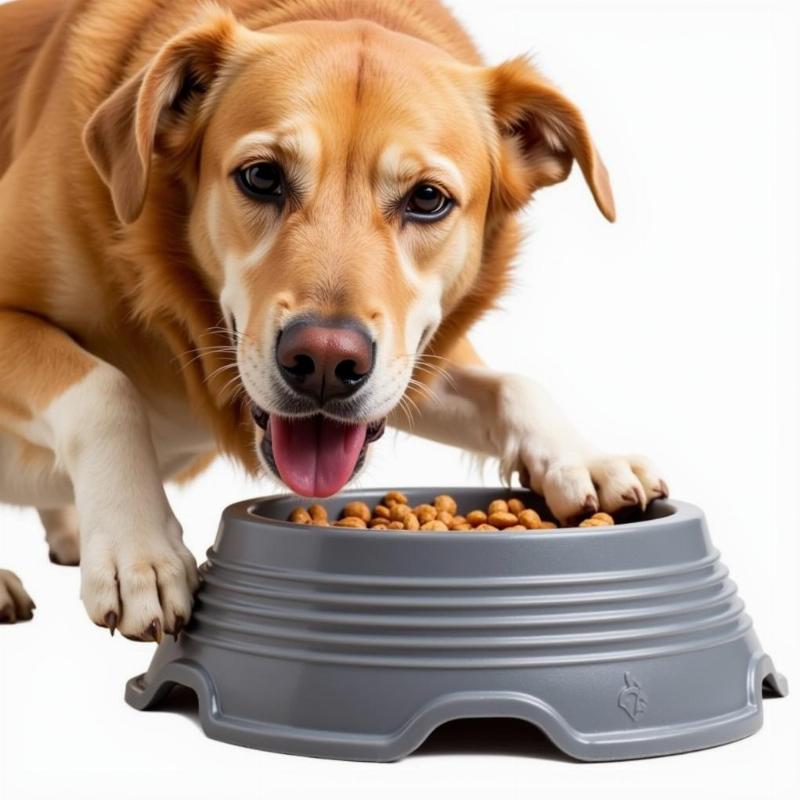Slow feeding is a growing trend among dog owners in the US, and for good reason. Large slow feeding dog bowls offer a simple yet effective solution to common canine eating problems, promoting healthier digestion and preventing potential health risks. For dogs who tend to gobble down their food in seconds, these bowls are a game-changer. They work by creating obstacles within the bowl, forcing your dog to slow down and eat more mindfully. This simple change can have a significant positive impact on your dog’s overall well-being.
Why Choose a Large Slow Feeding Dog Bowl?
Many dog owners are familiar with the frantic pace at which some dogs devour their food. This can lead to a range of digestive issues, including bloating, vomiting, and even Gastric Dilatation-Volvulus (GDV), a life-threatening condition commonly seen in large breeds. A large slow feeding dog bowl can help prevent these issues by slowing down the eating process. By making your dog work a little harder for each bite, these bowls promote better digestion and reduce the risk of gulping air, a primary contributor to bloating. Additionally, they can add a bit of mental stimulation to mealtime, turning a rushed activity into a more engaging experience.
 Lợi ích của bát ăn chậm cỡ lớn cho chó
Lợi ích của bát ăn chậm cỡ lớn cho chó
Selecting the Right Large Slow Feeding Dog Bowl
The market offers a wide variety of slow feeding bowls, so choosing the right one for your furry friend can seem daunting. Consider your dog’s size, breed, and eating habits. For large breeds, such as Mastiffs or Great Danes, ensure the bowl is large enough to comfortably accommodate their meal portions. best dog food for mastiffs. The material of the bowl is also important. Stainless steel is durable and easy to clean, while silicone offers flexibility and is often dishwasher-safe. silicone slow feed dog bowl.
Factors to Consider When Choosing a Bowl
- Size: A bowl that’s too small can be frustrating for a large dog, while one that’s too large might not effectively slow down their eating.
- Material: Stainless steel, ceramic, and silicone are popular choices, each with its own pros and cons. Consider durability, ease of cleaning, and potential allergies.
- Design: Different designs offer varying levels of difficulty. Start with a simpler design and progress to a more challenging one if needed.
Benefits Beyond Digestion
While digestive health is the primary benefit, large slow feeding dog bowls can also contribute to weight management. By extending mealtime, these bowls can help dogs feel fuller for longer, potentially reducing overeating. This can be particularly beneficial for dogs prone to weight gain. Furthermore, the mental stimulation provided by navigating the bowl’s obstacles can help alleviate boredom and reduce anxiety, especially in dogs who eat quickly due to stress. dog food bowl with lid.
How to Introduce a Large Slow Feeding Dog Bowl to Your Dog
Introducing a new feeding method should be a gradual process. Start by offering a small portion of your dog’s meal in the slow feeder and the rest in their regular bowl. Gradually increase the proportion of food in the slow feeder until they are comfortable eating their entire meal from it. Positive reinforcement, such as praise and treats, can encourage your dog to adapt to the new bowl. slow feeder insert for dogs.
Conclusion
Investing in a large slow feeding dog bowl is a proactive step towards improving your canine companion’s health and well-being. By promoting healthier eating habits, these bowls can contribute to better digestion, weight management, and even reduced anxiety. Choosing the right bowl, introducing it gradually, and offering positive reinforcement can make the transition smooth and enjoyable for both you and your furry friend. Remember, a happy tummy makes for a happy dog!
FAQ
- What are the signs of bloating in dogs? A distended abdomen, excessive drooling, restlessness, and attempts to vomit are common signs.
- Can any dog use a slow feeder? While most dogs can benefit, consult your veterinarian if your dog has specific dietary needs or medical conditions.
- How often should I clean my dog’s slow feeder? Clean it daily with warm soapy water, just like a regular dog bowl.
- What if my dog still eats too fast even with a slow feeder? Try a bowl with a more complex design or consider a slow feeder mat.
- Are slow feeders only for large dogs? No, they come in various sizes for all breeds.
- Can slow feeders help with dental health? While not a substitute for regular dental care, the increased chewing action can help remove some plaque and tartar.
- What if my dog refuses to eat from the slow feeder? Try different food textures or mix a small amount of wet food with their kibble to make it more appealing.
Related Articles
Beautdogs.us is your premier destination for all things dog-related in the US. We provide expert advice on dog breeds, care, and the best products available. Whether you’re a seasoned dog owner or just starting out, Beautdogs.us is your trusted resource. We offer comprehensive and engaging content on everything from nutrition and training to health and wellness, ensuring you have all the tools you need to be the best dog parent possible. Contact us for personalized advice at [email protected] or call us at +1 501-555-7529. Visit Beautdogs.us today for expert guidance and the latest information on canine care!